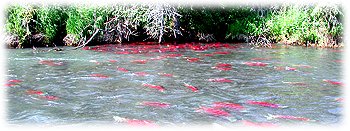

by Steve Duckett
| www.AlaskaFlyfishingOnline.com | ||
|
|

|

|
|
by Steve Duckett |
||
|
Helpful Area Fishing Maps Kenai Peninsula |
A good way to test a Bouncer is to look at it under water from the fish's point of view. A test tank can be made from a 5-10 gallon aquarium, or even from a clear plastic shoebox. This way you can see what distribution of beads gives the best action, and the minimum weight of beads to keep the hook point up. Sometimes a fly that looks just great on the vise does not look so good in the water; it is best to find this out before you have made 12 of them and are on a float trip a thousand miles from nowhere.
A truly superior test tank can be made from two pieces of 1/4" Lucite or polycarbonate, 10" x 20", with bottom and sides of the same material, about 4" wide. Use solvent-style contact cement to join, and seal the inside seams with clear silicone caulking compound. This tank can be easily front lit and back lit, and it is ideal for photography. With today's digital cameras with macro mode, you can capture subtle effects that can be too fast for the human eye, and you will have a satisfying record of your creations and of your progress in the quest to tie the perfect fly for Alaska (or anywhere else). Some Final Thoughts
If you want to paint your brass beads, threading them on a large safety pin first makes the job easier, and is a good place to store them. If you don't want the beads to click because the fish may be spooky, painting the beads with Softex will mute the sound. If foul hooking fish is a problem, and you don't want to tie on circle hooks, you can make a weedguard from a strip of 2mm x 6mm foam, tied in at the head and extending back to just above the point of the hook; the foam also helps keep the hookpoint riding up, so you may be able to decrease the weight of the beads if you want a more neutral weight of fly. Even though Bouncers are weighted, sometimes when fishing deep you need some additional weight on the leader a foot or so from the fly. This can be accomplished by putting a split shot above the tippet knot, but tangle-free casting becomes a challenge. The challenge can be reduced by using a cone-shaped weight with a central hole that slides a bit on the leader above the tippet knot. In engineering parlance, the extra degree of freedom of the sliding motion tends to “damp out" the bolo effect of two fixed weights. Cones weighing 1/64 ounce made for bass fishermen work well. Purists may want to avert their eyes, but further improvement is made if the tippet knot is replaced by a very small #12 crane swivel, which reduces tangles and acts as a more positive stop for the sliding cone. (The tiny swivel also works well in other situations, like attaching a heavy bite tippet, or in casting bass bugs that tend to spin and foul the leader.) We have had a lot of fun experimenting with the Bouncer style, and caught a lot of fish with these flies. Give the Bouncer patterns a try: we think you will be very pleased too. Editor's Note: Steve has been gracious enough to share a number of patterns he has tied using this innovative technique. We will be posting the recipes for these throughout the summer. In the meantime, we hope tiers will begin experimenting with modifying other successful patterns they use. You can visit Steve's website for further tying instructions by going to www.BouncerFlies.com
|